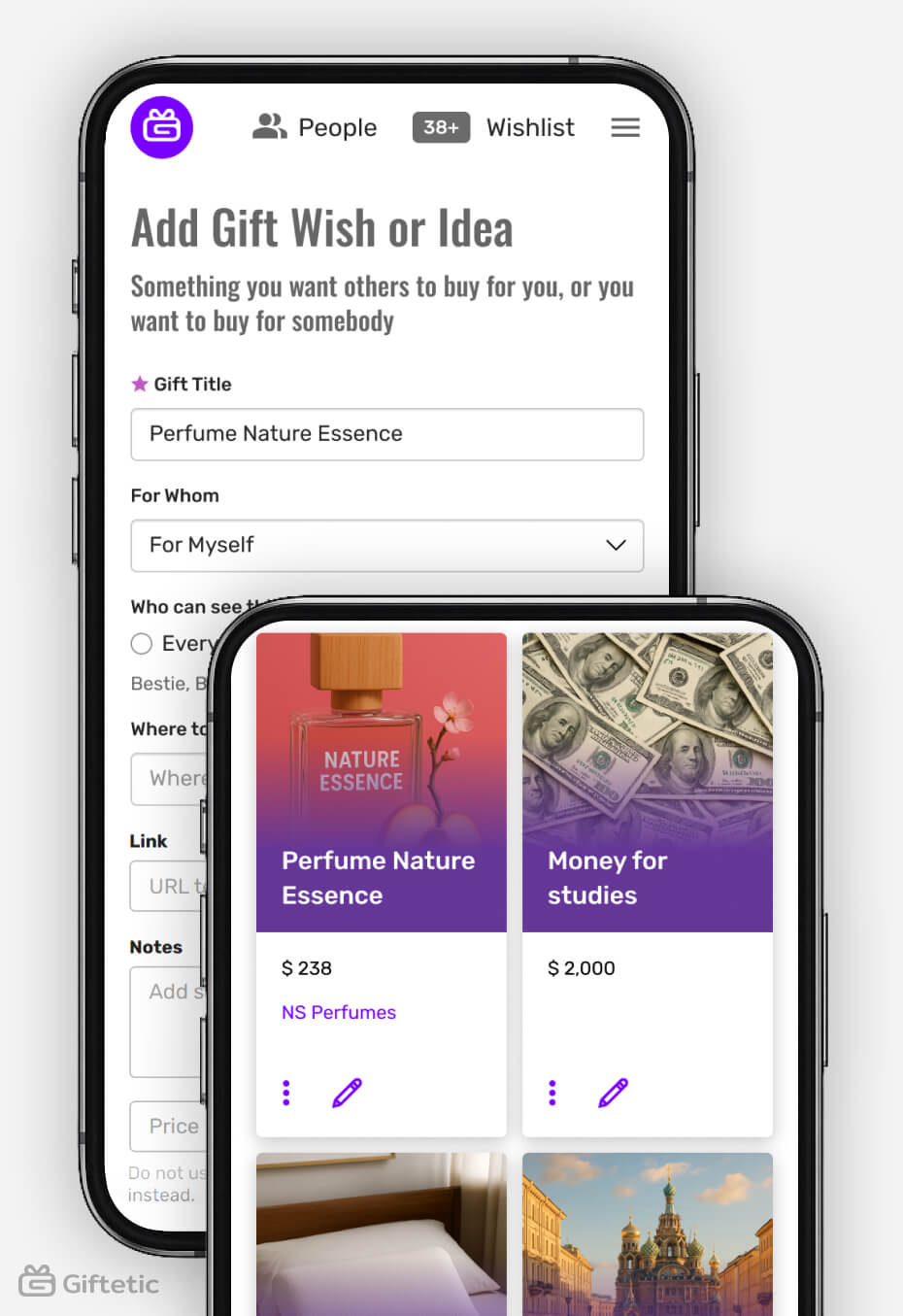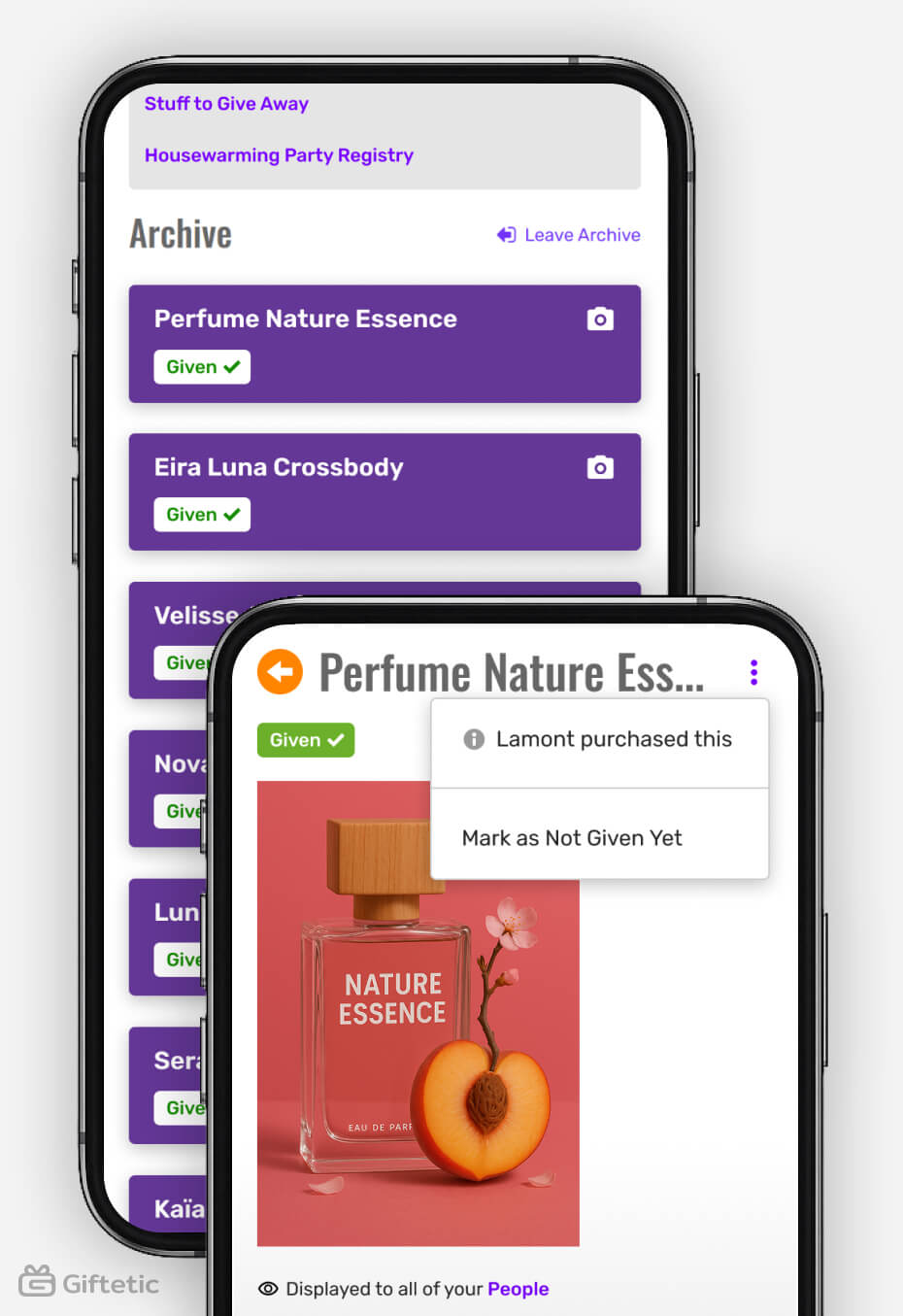What Is a Wishlist? Everything You Need to Know About How It Works and Why It Matters
From ancient scrolls listing precious offerings to modern digital gift registries, the human desire to express our wants and needs has remained constant throughout history. Today's wishlists — whether they're private collections of dream items or shared gift registries for special occasions — represent one of humanity's oldest practices: the art of communicating our desires to make giving and receiving more meaningful.
Just here for the digital wishlist? Skip ahead to what it means today.
Quick Summary (TL;DR)
- Wishlists have existed since ancient civilizations, evolving from oral traditions to written scrolls, religious offerings, and now digital platforms
- Modern wishlists serve multiple purposes: simplifying gift-giving, avoiding duplicates, organizing personal goals, and building stronger relationships
- Digital wishlists offer privacy controls, event tracking, and universal compatibility across different stores and platforms
- Today's wishlists range from wedding registries and birthday lists to personal goal-setting tools and charitable giving campaigns
- Effective wishlist platforms help users manage visibility, track gifting history, and maintain organized collections of meaningful items

The Universal Human Desire to Want
At its core, a wishlist is more than just a collection of desired items — it's a fundamental expression of human nature. Since the dawn of civilization, people have found ways to communicate their needs, hopes, and dreams to others. Whether carved into stone tablets or saved in smartphone apps, wishlists represent our innate desire to organize our thoughts, share our aspirations, and make the complex act of giving more meaningful.
The psychology behind wishlist creation runs deep. We create lists not just to receive things, but to clarify our own desires, set goals, and communicate our identity to others. A well-curated wishlist tells a story about who we are, what we value, and how we envision our future selves.
"The act of writing down what we want is itself a form of manifestation. It forces us to be specific about our desires and creates a roadmap for achieving them."
Before the Wishlist: Desire and Gifting in Early Societies
Long before written language existed, humans developed sophisticated ways of expressing and fulfilling desires within their communities. Archaeological evidence shows that even our earliest ancestors engaged in gift-giving rituals, from sharing food after successful hunts to creating elaborate burial offerings for the deceased.
In these oral traditions, desires were communicated through storytelling, gesture, and implication. A hunter might mention their need for a sharper spear, a mother might speak of her child's fascination with certain stones, or an elder might describe dreams of particular ceremonial items. These verbal "wishlists" were often embedded in daily conversations, seasonal celebrations, and coming-of-age rituals.
Ancient societies also developed formal systems for expressing collective desires. Tribal councils would discuss community needs, religious leaders would articulate spiritual requirements, and families would negotiate dowries and marriage gifts. These early practices laid the groundwork for our modern understanding of gift-giving traditions and wish fulfillment.
The First Real Wishlists: From Religious Offerings to Written Requests
The invention of writing systems revolutionized how humans could express and preserve their desires. Some of the earliest recorded wishlists appear in ancient Mesopotamian texts, where temple priests would maintain detailed inventories of offerings needed for religious ceremonies. These sacred lists included everything from specific types of grain and livestock to precious metals and rare incense.
Ancient Egyptian tombs provide fascinating examples of formalized wish fulfillment, with elaborate lists of items, foods, and services the deceased would need in the afterlife. These burial wishlists were meticulously planned and executed, often taking years to complete and representing some of history's most expensive gift registries.
Medieval Europe saw the rise of dowry lists and marriage contracts that functioned as early wedding registries. Families would negotiate detailed inventories of household goods, livestock, and property that would change hands during marriage ceremonies. These documents served both practical and social functions, ensuring newlyweds had everything needed to establish their household while displaying family wealth and status.
"The medieval dowry system was essentially a formalized wishlist negotiation between families, designed to ensure practical needs were met while maintaining social obligations."
Wishlists in Religion, Stories, and Tradition
Throughout history, religious and cultural traditions have embraced the concept of wishlist-making as a way to connect with the divine and express hope for the future. Ancient Greeks would throw coins into sacred wells while making wishes, creating physical representations of their desires. Roman soldiers would leave small offerings at roadside shrines, each item representing a specific request for protection or good fortune.
The tradition of writing letters to religious figures — from petitions to saints to modern letters to Santa Claus — represents one of the most enduring forms of wishlist creation. Children around the world still participate in this ancient practice, carefully crafting lists of desired gifts and mailing them to the North Pole. This tradition teaches important lessons about expressing gratitude, setting realistic expectations, and the joy of giving as well as receiving.
Folklore and mythology are filled with wishlist-adjacent concepts: Aladdin's three wishes from the genie, fairy godmothers granting Cinderella's dreams, and magical wells that grant wishes to those pure of heart. These stories reflect humanity's eternal fascination with the idea that our deepest desires might somehow be fulfilled through external intervention.
Many cultures have developed sophisticated seasonal wishing traditions. Chinese New Year includes the practice of writing wishes on lanterns and releasing them into the sky. Jewish traditions include writing prayers and inserting them into the Western Wall. These practices demonstrate how wishlists serve not just practical gift-giving purposes, but also spiritual and emotional needs for hope and connection.
The Wishlist in Print: Catalogs and Commercialization
The printing press revolutionized wishlist culture by making it possible to mass-produce catalogs, advertisements, and shopping guides. Suddenly, people could browse hundreds of available items from the comfort of their homes, circling desired products and sharing these improvised wishlists with family members.
The late 19th and early 20th centuries saw the rise of elaborate holiday wishbooks from major retailers like Sears, Montgomery Ward, and local department stores. These catalogs became essential tools for Christmas planning, with children poring over toy sections and adults marking household items they needed. Families would pass these catalogs around the dinner table, discussing possibilities and making informal gift registries for birthdays and holidays.
This era also saw the formalization of wedding gift registries at major department stores. Couples could visit stores, select items they wanted, and have their choices recorded in bound ledgers that friends and family could consult when shopping for wedding gifts. This system eliminated guesswork and reduced the likelihood of receiving duplicate or unwanted presents.
"The Sears catalog became known as the 'wish book' because it represented dreams made tangible — everything a family might want or need, all in one place."
Children's toy catalogs became particularly influential, with companies like FAO Schwarz and Toys"R"Us publishing elaborate holiday catalogs that doubled as dream lists. Parents would find these catalogs dog-eared and marked up, serving as clear communication about their children's desires and helping guide holiday gift-giving decisions.
The Digital Shift: How Online Wishlists Emerged
What Is a Digital Wishlist?
A digital wishlist is an online collection of desired items, experiences, or goals that you can create, organize, and share with others. Unlike traditional paper lists or store-specific registries, digital wishlists offer flexibility, privacy controls, and universal compatibility across multiple retailers and platforms. They serve as both personal organization tools and communication bridges that make gift-giving more thoughtful and efficient.
Key Advantages of Modern Digital Wishlists
| Feature | How It Works | Benefits |
|---|---|---|
| Private & Public Wishlists | Create personal wishlists and gift registries that can be shared via unique URL or QR code | Control who sees your wishes while making gift-giving easier for family and friends |
| Gift Ideas Organizer | Save and organize gift inspirations for others, ensuring you never forget great gift ideas | Stay prepared with thoughtful gift options for family, friends, colleagues, and loved ones |
| Gifting Contacts Manager | Built-in contact manager tracks birthdays, anniversaries, and other special occasions | Keep your gift recipient list organized and never miss important dates |
| Gift Tracking & History | Logs past gifts given and received to prevent duplicate gift-giving | Avoid giving the same gift twice and track your gifting patterns over time |
| Smart Event Reminders | Timely notifications give you advance notice for events such as birthdays and relevant holidays | Plan ahead and never miss meaningful gifting opportunities |
| Granular Privacy Control | Set visibility for each individual wishlist item — public, private, or restricted to specific people | Share appropriate items with different people while keeping some completely private |
Modern digital wishlist platforms, such as Giftetic, provide thoughtful tools that go far beyond what was possible in the analog era. Users can create private or public wishlists, manage gifting ideas for family and friends, track important events like birthdays, and even maintain wishlists on behalf of others — such as children or elderly parents. Giftetic also offers full privacy control for each wishlist or individual item, keeps a history of past gifts, and sends timely reminders to help users plan ahead and never miss a meaningful occasion.
How Digital Wishlists Work: A Step-by-Step Example
To understand how modern digital wishlists function in practice, let's walk through a typical user experience from creation to gift fulfillment.

Creating Your First Wishlist
When users create an account on a platform like Giftetic, they automatically receive a default general wishlist immediately after registration. This personal wishlist serves as their main collection where they can start adding desired items right away.
Melody, a Giftetic user, has been using the digital wishlist platform for a few months, adding items to her automatically created general wishlist whenever she discovers something interesting. As her 30th birthday approaches, she decides to focus on updating this default wishlist with birthday-specific items. Her previously invited family members and close friends can already access this wishlist and will see the new items she adds.
Adding Items and Preferences
As Melody browses online or visits stores, she adds items to her wishlist:
- A perfume she has been wanting for a long time (with a note about the specific scent and bottle size)
- Money for studies to elevate her career (allowing multiple people to contribute toward her professional development fund)
- A memory foam pillow to support her aching neck after long hours of desk work (including firmness preference and pillow size)
- Tour tickets to explore a city she has always dreamt to visit (with preferred dates and tour type suggestions)


Sharing and Managing Visibility
Melody's gifting contacts follow her on the platform and are automatically notified about her newly added gift wish items.
Using the privacy controls, she sets different visibility levels for individual items: the perfume and memory foam pillow are visible to all her connected family and friends, while the expensive tour tickets are only visible to specific people like her parents and siblings in her gifting connections. The studies fund contribution is set as visible to all her close friends, allowing multiple people to contribute toward this larger goal.
Gift Status Management and Archives
When her brother, Lamont, purchases the perfume, he marks it as "purchased" on the platform, which immediately hides the item from other gift-givers to prevent duplicates. Melody doesn't see any changes to her wishlist at this point, maintaining the element of surprise.
After her birthday celebration, when her brother gives her the perfume, he or she can mark it as "given" in the system. The item becomes visible in the gifting archive for others when marked as "purchased," but Melody can only see it in her archive once it's marked as "given."


Other Gift-Giver Experiences
Meanwhile, Melody's aunt visits the shared wishlist and can easily see available items to gift, read Melody's notes about preferences, and choose something within her budget by filtering the wishlist by price.
The platform informs her that Melody is turning 30 (a milestone birthday) and sends reminders as the date approaches, giving her enough time to purchase and prepare the gift in advance, plus a final reminder on Melody's actual birthday.
After each celebration, the platform keeps records of which gifts were given by whom, creating a gift history stored in the archive that helps Melody write personalized thank-you notes and helps her family remember what they've given her in previous years.
This seamless process demonstrates how digital wishlists transform gift-giving from guesswork into thoughtful, coordinated experiences that benefit both givers and receivers.
Create your free Giftetic account now
How Digital Wishlists Evolved
The internet fundamentally transformed how people create, manage, and share their wishlists. Early adopters began using email to send links to desired items, bookmarking favorite products in web browsers, and maintaining simple text documents with gift ideas. These rudimentary digital wishlists offered unprecedented flexibility — people could include items from any store or website, add detailed notes about preferences, and easily update their lists as desires changed.
The late 1990s and early 2000s saw the emergence of dedicated wishlist platforms that allowed users to save items from vast online catalogs. This innovation made it simple for people to create comprehensive lists spanning multiple categories, from books and electronics to home goods and clothing. The ability to share these lists via email links revolutionized gift-giving occasions, making it easier than ever for gift-givers to choose meaningful, wanted presents.
As social media platforms gained popularity, wishlists began taking on more social characteristics. People started sharing their desired items on Facebook, Pinterest, and Instagram, turning gift registries into lifestyle statements and inspiration boards. This shift reflected changing attitudes about expressing desires — what was once considered somewhat presumptuous became accepted as helpful and considerate.
These platforms have evolved into comprehensive personal gifting management systems that serve both wishlist creators and gift-givers, making the entire process more thoughtful and efficient.
Types of Digital Wishlists and Their Purposes
Understanding the different categories of modern wishlists can help you create more effective lists and choose the right approach for various situations in your life.
Common Wishlist Categories
- Special Event Registries — Wedding registries for building shared households, baby shower lists for new parents, birthday wishlists for clear gift guidance, graduation celebrations, housewarming parties, and anniversary milestones
- Personal Ongoing Collections — Year-round repositories for books to read, gadgets to research, home improvement projects, clothing considerations, and items you want to remember for future purchase
- Experience and Memory Lists — Concert tickets, cooking classes, travel destinations, spa treatments, adventure activities, educational workshops, and other meaningful moments that create lasting memories
- Charitable and Community-Focused Lists — Donation requests to favorite causes, items needed by local organizations, purchases supporting small businesses, ethical brand products, and "giving lists" replacing traditional material gifts
- Professional Development Collections — Industry books, online courses, conference tickets, skill-building tools, software subscriptions, and membership programs supporting career advancement
- Lifestyle and Hobby Lists — Fitness equipment, art supplies, gardening tools, cooking gadgets, outdoor gear, and specialized equipment for personal interests and recreational activities
- Family and Group Wishlists — Shared household needs, family vacation ideas, children's wish collections, elderly parent care items, and collaborative lists for extended family coordination
Privacy and Sharing Strategies
The most effective modern wishlists often combine multiple categories, using advanced privacy controls to share appropriate items with different groups while maintaining one comprehensive, organized system. Many people find that maintaining a continuously updated personal wishlist ensures they always have thoughtful answers when friends ask for gift suggestions.
Why People Use Wishlists Today
Modern wishlists serve multiple practical and emotional purposes that go far beyond simple gift coordination. Understanding these motivations can help both wishlist creators and gift-givers use these tools more effectively.
The primary practical benefit is eliminating guesswork from gift-giving. Rather than hoping a gift will be appreciated, givers can choose from pre-approved options that they know will be valued and used. This reduces the stress of gift selection and increases the likelihood of giving something truly meaningful. For gift recipients, wishlists ensure they receive items they actually want rather than accumulating unwanted objects that create clutter and waste.
Avoiding duplicates becomes particularly important for major life events like weddings, where multiple guests might otherwise choose similar gifts. Modern wishlist platforms can track which items have been purchased, automatically hiding them from other potential gift-givers to prevent duplication.
Many people use wishlists as personal organization tools that help them clarify their own desires and priorities. The act of curating a wishlist forces people to think specifically about what they want, why they want it, and how it fits into their life goals. This reflection can lead to more intentional purchasing decisions and better self-awareness about personal values and preferences.
Budget planning represents another significant benefit. By maintaining ongoing wishlists, people can track prices over time, wait for sales on desired items, and make more strategic purchasing decisions. Some platforms even send notifications when wishlist items go on sale, helping users save money on planned purchases.
"A thoughtful wishlist is really a form of communication — it tells people not just what you want, but who you are and what you value."
For busy gift-givers, wishlists serve as time-saving tools that streamline the shopping process. Rather than spending hours wandering through stores or browsing online sites, they can quickly reference curated lists and choose appropriate gifts with confidence. This efficiency is particularly valuable during busy holiday seasons or when managing multiple gift-giving occasions.
Wishlists as Tools for Intentional Living
Beyond their gift-giving applications, modern wishlists have evolved into powerful tools for personal development and intentional living. Many people use wishlist creation as a form of goal-setting and self-reflection that helps them align their desires with their values and long-term objectives.
The minimalist movement has particularly embraced wishlists as tools for conscious consumption. Rather than making impulsive purchases, minimalists often maintain carefully curated lists of items they genuinely need or would significantly improve their lives. This approach involves thoroughly researching potential purchases, considering their long-term utility, and ensuring they align with personal values before adding them to a wishlist.
Creating and regularly reviewing wishlists can serve as a form of values clarification exercise. By examining what we want and why we want it, we can identify patterns that reveal our underlying priorities and motivations. Someone whose wishlist consistently includes books, educational courses, and learning experiences is clearly prioritizing intellectual growth. Another person whose list focuses on outdoor gear, travel experiences, and adventure activities is demonstrating different values around exploration and physical challenge.
Many people find that revisiting old wishlists provides valuable insights into how their priorities and interests have evolved over time. Items that seemed essential a year ago might now feel irrelevant, while new categories of desires emerge as life circumstances change. This evolution can guide future decision-making and help people stay aligned with their current values and goals.
"Your wishlist is like a mirror of your aspirations. It shows not just what you want, but who you want to become."
Professional organizers and life coaches often recommend using wishlists as part of broader goal-setting and life planning processes. By categorizing desires into different areas of life — career development, health and fitness, relationships, hobbies, home improvement — people can ensure they're pursuing balanced growth across multiple dimensions of their lives.
The Role of Giftetic in How People Manage Wishlists Today
As wishlist technology has evolved, many users have encountered limitations with store-specific registries that lock them into single retailers or platforms that don't offer sufficient privacy and organization options. This has created demand for more flexible, user-controlled wishlist solutions that prioritize the list creator's needs over commercial interests.
Universal wishlist platforms like Giftetic address these limitations by allowing users to create comprehensive lists that include items from any store or website, without being restricted to a single retailer's inventory. This approach gives users more control over their wishlist content while providing better privacy options and organizational tools.
Modern wishlist platforms excel when they offer sophisticated relationship management features that help users organize their gift-giving obligations and track their gifting history. These tools can include reminders for important dates, records of past gifts given and received, and suggestions for appropriate gift categories based on relationship types and special occasions.
The best contemporary wishlist platforms also recognize that different items require different levels of privacy and sharing. While some desires might be appropriate to share publicly, others might be intended only for close family members or romantic partners. Granular privacy controls allow users to customize sharing permissions at the item level, ensuring appropriate visibility for different categories of desires.
Advanced features like smart event reminders and inspiration collections help users stay organized across multiple relationships and occasions, making it easier to be thoughtful and consistent in their gift-giving practices. These tools recognize that successful gift-giving requires ongoing attention and organization, not just last-minute shopping.
The Wishlist — An Ancient Practice Made Modern
From ancient temple offering lists to sophisticated digital platforms, wishlists represent one of humanity's most enduring practices: the desire to communicate our hopes, needs, and dreams to others who care about us. What began as practical inventory management has evolved into a complex social and emotional tool that serves multiple purposes in our modern lives.
Today's wishlists function simultaneously as gift coordination tools, personal organization systems, relationship building devices, and self-reflection instruments. They help us clarify our desires, communicate our values, and strengthen our connections with family and friends through more thoughtful giving and receiving.
The evolution of wishlist technology continues to reflect changing social attitudes about expressing desires, accepting help, and building community through shared experiences. As our culture becomes more comfortable with explicit communication about needs and wants, wishlists serve as bridges between individual desires and collective care.
Whether maintained for practical gift-giving coordination or personal goal-setting purposes, the most effective wishlists share common characteristics: they're thoughtfully curated, regularly updated, and aligned with the creator's authentic values and priorities. They serve not as demands for material acquisition, but as windows into the personalities, aspirations, and relationships that give our lives meaning.
As we continue to navigate an increasingly complex world of choices and possibilities, wishlists provide valuable tools for intentional living and meaningful connection. They remind us that our desires, when understood and communicated thoughtfully, can become pathways to deeper relationships and more fulfilling lives. In this way, the ancient practice of wish-making continues to serve essential human needs in our modern digital age.
"The best gifts come from understanding not just what someone wants, but why they want it. A good wishlist tells both stories."





